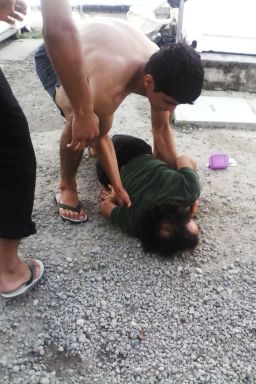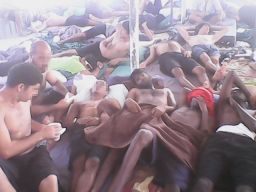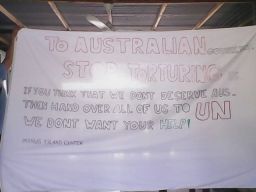Story highlights
Hunger strikes enter ninth day on Manus Island, Papua New Guinea
1,200 asylum seekers who entered Australian waters have been taken there for processing
They fear plans to move some to another facility will leave them vulnerable to attack from locals
From beneath his bed, an asylum seeker types messages on a phone smuggled into Manus Island detention center in Papua New Guinea, as two friends keep watch.
“No crime to seek asylum, we are in manus jail.”
He’s been there for 18 months and now finds himself witness to a mass hunger strike by as many as 700 fellow asylum seekers or transferees, as they’re called.
He said he hasn’t joined them because he fears that the respect he has in the compound means he could be singled out as a troublemaker, and that if he was taken to the medical center, he wouldn’t be allowed back.
He has asked not to be named.
Photos sent from the mobile phone he keeps hidden from guards show dozens of hunger strikers lying bare-chested on the concrete floor of the detention compound.

“Many people fall,” he wrote, sending an image of man lying outside on the gravel with the message: “no power in his body.”
Severe cases of self-harm
Asylum seekers in the Australian offshore processing center have been declining food for nine days.

They’re protesting against the Canberra government’s plans to send around 50 confirmed refugees to another facility in Lorengau, the capital of Manus Province. The first of the transfers are due to start on Thursday.
Both the PNG and the Australian governments have said that the move is only temporary, and it’s part of a program that will see some refugees resettled elsewhere in Papua New Guinea. Still, the asylum seekers – and government critics – have expressed concerns.
“It’s simply moving them to a different type of accommodation, an accommodation that asylum seekers are fearful is not going to keep them safe from resentment in the local community,” said Australian Greens Senator Sarah Hanson-Young, an outspoken critic of the government’s policy.
So fearful are they of moving, some asylum seekers have resorted to self-harm.
The PNG government has confirmed some have sewn their lips together, or swallowed washing powder or metal filaments from disposable razors.
Authorities have not revealed how many people have been treated by medical staff at the site, and information coming from advocates and those inside the prison is difficult to confirm.
“It’s extremely challenging to verify the information that we’re getting,” said Amnesty International’s Graeme McGregor, who said even under normal circumstances communication for the asylum seekers is “very limited.”
Fears of local violence
On Monday afternoon, security forces ended a standoff with transferees in the Delta compound, one of four compounds at the center. The transferees had barricaded the gates so that no one could enter or leave.
PNG’s Foreign Affairs Minister Rimbink Pato said the standoff was resolved peacefully with no serious injury. In contrast, advocates said the compound came under “attack” by security forces and transferees were seen being dragged away in handcuffs.
Australian Immigration Minister Peter Dutton on Tuesday conceded a “degree of force” was involved, but said the PNG government deserved praise for its professionalism in handling the situation.
Earlier he accused some advocates of aggravating the situation by spreading “false and misleading claims,” including reports the asylum seekers were being denied food and water.
“There are no false and misleading claims and the minister can’t point to any,” said Ian Rintoul, from the Refugee Action Coalition in Sydney. “Yet again, the immigration department tends to point to some unspoken, unnamed minority when it’s really the government’s policy that are really the driving force of the protests.”
Murder threats
Conditions in the detention center have been the subject of criticism and complaint since it re-opened in November 2012 as the primary site for the processing of offshore asylum claims for people who arrive in Australian waters by boat. The Australian government has said the center meets international obligations.
Since then, the mental health of the transferees has suffered, according to rights advocates, and relations with the local community have been damaged to the point that the men fear for their lives outside the center’s perimeter.
“They’ve had constant threats, just last week, that they will be killed, that (locals) will settle accounts with them outside the detention center,” Rintoul said.
The worst of the threats started 12 months ago, when a 23-year-old Iranian asylum seeker, Reza Berati, was killed after days of protests erupted into violence. Dozens were injured during clashes between asylum seekers, guards and locals who entered the facility.
An independent report commissioned by the government into the riot found Berati “suffered a severe brain injury caused by a brutal beating by several assailants and died a few hours later.”
Last summer, two PNG nationals were arrested, including the alleged leader of the attack who had been employed at the center.
Resentment outside, resentment inside
The alleged involvement of locals – and the fact that several alleged assailants may still be at large – has raised fears inside the detention center that they’ll be targeted if not protected. The government has said security is adequate and refugees can call on the police if needed.
Senator Hanson-Young visited the island before the riot, in 2013, and said even then it was clear to her that the local feeling of animosity toward the asylum seekers was “pretty severe.”
“The local community think they’re criminals in a prison. They think they are people who must have done something wrong – and they’re being told that these people are going to be living in their community,” she said.
But she said a lot of the ill feeling relates to the huge pay disparity between the local and the expat employees.
“The locals get paid $4.50 and hour, versus the $45 per hour for expats. That has always an issue of contention that has led to a lot of resentment about the facility overall,” she said.
‘Help us’

From his contraband phone, the transferee sends more images of signs, the words written neatly in capital letters on sheets hung in the compound.
“TO AUSTRALIAN GOVERNMENT. STOP TORTURING US. IF YOU THINK WE DON’T DESERVE AUS. THEN HAND OVER ALL OF US TO THE UN. WE DON’T WANT YOUR HELP!”
The Australian government has said the Manus Island transferees are free to return to Afghanistan, Iraq, Iran, or wherever they came from. If they ask, they’ll receive government assistance to go back.
However, Senator Hanson-Young said that option is not being taken up by desperate people who once fled in fear of their lives.
“Anyone who is still left here now is because they’ve got no other choice.”
Asked why he doesn’t volunteer to leave, the transferee texts: “I will die if I go back.”

